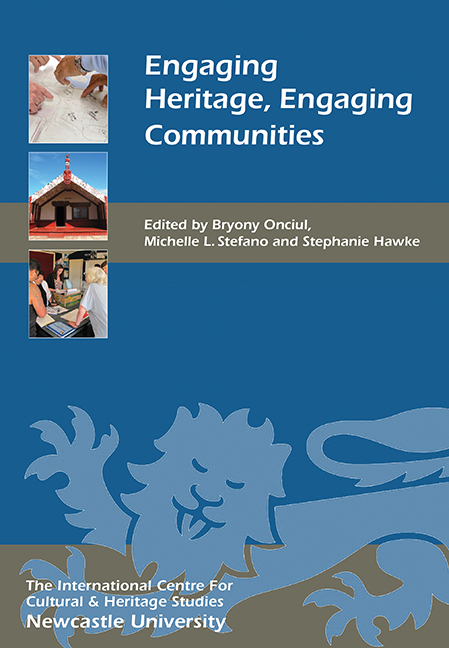Book contents
- Frontmatter
- Contents
- List of Illustrations
- Acknowledgments
- Introduction
- Engaging Concepts
- Engaging Creatively
- 7 Re-imagining Egypt: Artefacts, Contemporary Art and Community Engagement in the Museum
- 8 Interview – Evita Buša
- 9 Interview – Shatha Abu Khafajah
- 10 Engaging Communities of De–industrialisation: the Mapping Baybrook and Mill Stories Projects of Baltimore, USA
- 11 Interview – Ashley Minner
- Engaging Challenges
- List of Contributors
- Index
- Miscellaneous Endmatter
11 - Interview – Ashley Minner
from Engaging Creatively
Published online by Cambridge University Press: 13 April 2017
- Frontmatter
- Contents
- List of Illustrations
- Acknowledgments
- Introduction
- Engaging Concepts
- Engaging Creatively
- 7 Re-imagining Egypt: Artefacts, Contemporary Art and Community Engagement in the Museum
- 8 Interview – Evita Buša
- 9 Interview – Shatha Abu Khafajah
- 10 Engaging Communities of De–industrialisation: the Mapping Baybrook and Mill Stories Projects of Baltimore, USA
- 11 Interview – Ashley Minner
- Engaging Challenges
- List of Contributors
- Index
- Miscellaneous Endmatter
Summary
Could you describe the role ‘heritage’ plays in your life?
Well, let me start by saying that I have a strong sense of ‘where I'm from’ and ‘who I'm from’. I am a native Baltimorean – as in, I was born and raised just across the Baltimore City line, in a neighborhood of Dundalk that was once called the ‘Royal Homes’. I grew up on one side of the block; now I live on the other side of the same block. All of the houses began as identical Cape Cod-style concrete bungalows. They were built as temporary housing for soldiers returning from World War II that were eventually occupied by workers of the Sparrows Point Steel Mill, located nearby.
Many of the mill workers, and those working in other Baltimore-based industries, were transplants from southern states, like my grandparents, who came from North Carolina, Tennessee, Virginia and West Virginia, respectively. My mother's father was a Lumbee Indian; my mother's mother was of Muscogee (Creek) and European descent. My father's mother was of English descent and her family lived first in west Baltimore City, and then in the Sparrows Point area after moving up from Virginia. My father's father is of Swiss (European) ancestry, and grew up in the town of Swiss, West Virginia.
I was lucky enough to grow up with most of my grandparents nearby, as well as an aunt and uncle who were living only a few doors away. Other aunts, uncles and cousins often came to visit. Everyone brought accents, stories, recipes, songs, instruments, photographs and other treasures with them. They shared a lot with me as I was growing up. I was (and still am) proud of our family heritage and always interested in learning more about it. We also took trips back down south, to all four states.
Being ‘mixed’ Lumbee and white, I looked different from most of my classmates, so that fact of my identity was not one I could really ignore, even if I wanted to. There were not too many Lumbee children at my schools because most of the Lumbee families in Baltimore lived in the city proper. My Lumbee aunt, who lived across the street from me, was in charge of the Title VII Indian Education Program in Baltimore City Public Schools.
- Type
- Chapter
- Information
- Engaging Heritage, Engaging Communities , pp. 139 - 144Publisher: Boydell & BrewerPrint publication year: 2017

